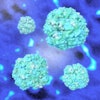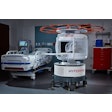
Background parenchymal enhancement (BPE) on breast MRI has already been linked to breast cancer risk in women undergoing mammograms. Now, a new study has found a connection between BPE and genetic mutations that are indicators of higher breast cancer risk.
In a talk at the 2021 virtual annual meeting of the American Roentgen Ray Society (ARRS), researchers from the University of California, Los Angeles (UCLA) sought to identify imaging features that predict a higher risk for breast cancer by comparing BPE between high-risk women and average-risk women. They found that high BPE is significantly correlated with the BRCA gene mutation, an indicator of high risk for breast cancer.
Background parenchymal enhancement -- the enhancement of normal fibroglandular tissue on breast MRI -- has been investigated as a potential imaging biomarker for breast cancer risk. BPE levels can be affected by hormones such as estrogen, and as such, breast MRI is best performed on days 7-12 of a woman's menstrual cycle, when levels are at their lowest.
Among high-risk patients, those with higher levels of BPE have been shown to have 2.1-2.5 times the risk of developing breast cancer compared with those with low BPE levels. There are four categories of enhancement: minimal, mild, moderate, and marked.
Increased background parenchymal enhancement has been found to be caused by current hormonal status in premenopausal women and is rarely seen in postmenopausal women. BPE could also affect MRI interpretations, resulting in both false-positive and false-negative reads.
At ARRS 2021, the UCLA team discussed their work in which they retrospectively analyzed 509 women who received 3-tesla breast MRI scans for screening and who had no history of breast cancer or mastectomy from January 2019 to December 2019. The women were grouped into four groups, and their levels of BPE enhancement were scored using the BI-RADS lexicon on a scale of 1-4, with 1 meaning "minimal" background enhancement and 4 equating to "marked" enhancement.
- Carriers of BRCA 1/2 germline mutations marked BPE 2.2%
- Carriers of non-BRCA germline mutation -- 2.3%
- Women at lifetime risk of 20% or more -- 12.7%
- Women who were not at high risk for breast cancer 0%
| Average level of BPE enhancement (scale of 1-4) | Percent of women in study with "marked" BPE | |
| Carriers of BRCA 1/2 germline mutations | 1.75 | 2.2% |
| Carriers of non-BRCA germline mutation | 2.28 | 2.3% |
| Nonmutation carriers at lifetime risk of 20% or more | 2.34 | 12.7% |
| Women who were not at high risk for breast cancer | 1.93 | 0% |
Out of all clinical factors that could be linked to higher BPE levels -- such as age, menopause, or hormonal therapy status -- only BRCA mutation showed statistical significance, with an odds ratio of 0.38 (p = 0.02).
When high BPE is observed in BRCA mutation carriers, these women are likely at higher risk for breast cancer and may benefit from chemoprevention, the research team said in its abstract. They also said the differences are possibly influenced by the molecular and vascular environment related to genetic alteration of hormonal status.
Dr. Wakana Murakami from UCLA told AuntMinnie.com that future studies would include developing more defined levels of BPE either quantitatively or qualitatively.
"This will improve sensitivities between BPE levels and breast cancer risk, considering BPE levels are at their lowest," she said.
The team plans to evaluate BPE quantitatively to investigate the correlation between breast cancer risk stratification and BPE levels.



.fFmgij6Hin.png?auto=compress%2Cformat&fit=crop&h=100&q=70&w=100)





.fFmgij6Hin.png?auto=compress%2Cformat&fit=crop&h=167&q=70&w=250)











